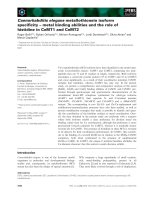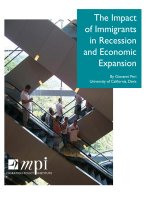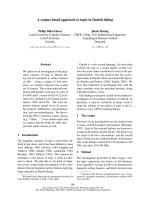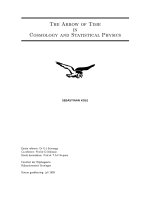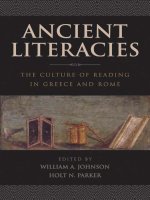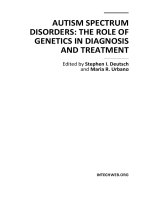The gulf of mexico oil spill a corpus based study of metaphors in british and american media discourse 6 1
Bạn đang xem bản rút gọn của tài liệu. Xem và tải ngay bản đầy đủ của tài liệu tại đây (1.37 MB, 35 trang )
256
CHAPTER 6
METAPHORS IN AMERICAN & BRITISH
MEDIA DISCOURSE:
A CROSS-CULTURAL PERSPECTIVE
6.1 Introduction: The American broadsheets vs. the British
broadsheets (A comparative approach)
Musolff (2004, p.61) states that the specific function of metaphors in
political (and media) discourse is to “frame arguments into stereotypical
scenarios that suggest particular conclusions”. In other words, Musolff sees
metaphor as a persuasive tool that effectively exploits our specific cultural
values in order to evoke a particular outlook desired by those in power. He
goes a step further by stating that these metaphors are “best analysed by way
of the distributional analysis of sufficiently large amounts of corpus data
which reveal the usage patterns and relative dominance of certain scenarios”.
Hence, this particular study aims to combine the functions of two leading web-
based concordancing software to document and analyse the aggregate
metaphorical framings pertaining to the BP oil spill. The overarching aim is to
establish a methodology that is inductive, empirically based and most
importantly, repeatable.
At this juncture, it is important to note that while this study aims to
explicitly identify and critique the aggregate range of conceptual metaphors
and their corresponding scenarios in the target corpora, the resultant analysis is
not value neutral. This is simply due to the fact that the entire categorical slots
for participant roles and narratives are generated from the analyst’s
257
perspectives that are constrained by socio-cultural experiences and
stereotypes. Hence, while other readers and metaphors analysts are free to
challenge, reify and recontextualise the associated scenarios and conceptual
metaphors, it is hoped that the IICM provides an empirical and inductive
platform for metaphorical analysis in large representative corpora that would
result in useful methodological uniformity. This would provide a common
platform for subsequent metaphorical disagreements and discussions.
As a definitive statement on a broadsheet’s stance cannot be made
from a single study due to the inherent limitations in any corpus and in the
scope of the study, all the statements and claims made in this thesis are
generalisable only to this dataset, and are not extendable to each broadsheet’s
overarching political stance per se until further validation across a wider range
of comparable studies are carried out. The findings in this thesis are the result
of the careful compilation of 250 articles EACH from four separate
broadsheets, all gleaned according to strict criteria and in accordance to a pre-
determined timeframe. It is important to note that the analysis is streamlined
into two broad evaluative categories across both American and British media
discourse:
1. The potentially nationalistic portrayal of the key players in the entire
disaster: Namely the respective evaluative stances taken towards BP
and the US Government (specifically, the Obama administration, the
Bush administration and the associated range of governmental agencies
like the MMS).
258
2. The pre-eminence of the WAR/CRIME/CONFLICT metaphors across all
four corpora: With particular emphasis placed on the variations in the
aggregate framing of the disaster e.g. the predominance of HEALTH
AND DISEASE vs. NATURAL DISASTER scenarios, the metaphorical
foregrounding of nationalistic sentiments (and the relentless pursuit of
justice) vs. the emphasis on pragmatic economic considerations,
predominantly framing business as CONFLICT.
Table 6.1 below presents an aggregate overview of the two broad
evaluative categories stated above:
Table 6.1 – Aggregate comparison of metaphor types in British and American Broadsheets (G
& TT, NYT & WP):
Conceptual Key
NYT
(Types/ Tokens)
%
WP
(Types/ Tokens)
%
G
(Types/ Tokens)
%
TT
(Types/ Tokens)
%
THE OIL SPILL
WAR/CRIME/THREAT
56.1
54.9
54.1
53.6
47.5
42.3
64.4
68.1
BP/ OIL INDUSTRY
DEBTOR/CRIMINAL /
ENEMY/INCOMPETENCE/
PRAGMATIC
OPPORTUNIST/RECKLESS/
OUTDATED/ GREEDY/
(PERSONIFICATION: NEGATIVE)
25.6
31.9
21.1
22.8
14.1
21.4
18.8
22.6
BP/ OIL INDUSTRY
FIGHTER/ CONTRITE CHILD/
SCAPEGOAT/ ENTREPRENEUR/
PHILANTHROPIST/
COSMOPOLITAN ENTITY/
INVITED GUEST/ ACQUITTED
DEFENDANT/VICTIM/PREY
(PERSONIFICATION: POSITIVE)
10.6
10.4
14.4
16.2
21.9
25.3
30.1
36.4
THE US GOVERNMENT/
OBAMA ADMINISTRATION
CRIMINAL/ INCOMPETENT
(PERSONIFICATION: NEGATIVE
21.8
21.4
16.5
15.4
8.3
9.9
9.0
9.2
THE US GOVERNMENT/
OBAMA ADMINISTRATION
PARENT/ EEFECTIVE LAW
ENFORCER
(PERSONIFICATION: POSITIVE)
13.9
7.5
10.1
10.4
8.5
7.3
2.3
7.1
259
Summing up the results of the aggregate empirical analysis and the
metaphor conceptual keys mined from the IICM, it is clear that the corpora
from the conservative broadsheets (WP-Corpus and the TT-corpus) generate a
significant proportion of conceptual metaphors that focus on the mitigation
and negation of BP’s culpability in the entire oil spill. This can be seen in the
specific nature of the embodiment within the WAR/CRIME/THREAT conceptual
key in the WP-corpus (53.6%) and TT-corpus (68.1%), conceptualising
BUSINESS as a WAR/ GAME OF SURVIVAL in an effort to justify BP’s continued
economic survival. On the other hand, the metaphors mined from the more
liberal broadsheets (NYT-Corpus and the G-Corpus) focus on the scale of the
disaster and emphasise the range of negative emotions arising from the BP Oil
Spill, favouring a narrative centering on the pursuit of justice and the
relentless castigation of culpable parties. This can be seen in the higher
percentage of negative evaluations for the key players in the oil spill in the
NYT and G-corpus. Thus, it would appear that the corpora gleaned from the
conservative broadsheets adopt a less explicit, and a more subtle and mitigated
approach to the metaphorical evaluation of the key actors in the oil spill – in
an effort to foreground the more pragmatic, pro-business editorial ideology.
This is in contrast to the corpora obtained from the liberal broadsheets which
are more focused on the more explicit and intense metaphorical framings of
the scale of the disaster and on the ideological adherence to notions of justice
and ecological sustainability.
However, it is important to note that in most of these cases, the
differences amongst all four broadsheet corpora are lesser than expected from
our preconceived biases. In a comparable study done by Semino (2002, p.4-5)
260
where she analyses the metaphorical representations of the euro in British and
Italian newspapers, “overarching similarities” were found in the metaphorical
patterns involving the euro in both sets of newspapers. Semino attributed these
similarities to two main factors.
1. The “significant similarities in the conceptual metaphorical systems
underlying (British) English and Italian”.
2. The “predictable mutual influences between reports about the euro in
different countries”.
While Semino’s observations are somewhat transferable to the context of
this analysis, it is important to note that there are significant differences in the
frequencies of the various types of metaphors as well as in the subtle
metaphorical realisations of the same source domain within this study. This
can be attributed to the differences in the dominant attitudes and editorial
perspectives to the oil spill in accordance to specific experiential embodiments,
cultural influences and political affiliations that are captured within these
specific corpora subsets. These subtle metaphorical textures will be uncovered
in the subsequent analysis in this chapter.
The analysis for this chapter will take the following structure:
• A detailed cross-cultural comparison of the range of analogy-based
metaphors identified by the IICM across the four empirically-salient
USAS domains analysed in this thesis:
261
1. Substances & Materials: Liquid (NYT_1/ WP_1/G_1/TT_1)
2. Speech: Communicative (NYT_2/ WP_2/ G_6/TT_8)
3. Damaging and Destroying (NYT_5/WP_5/G_7/TT_6)
4. Green Issues (NYT_11/WP_7/G_5/TT_10)
The metaphors mined from these four domains will be analysed with
reference to another new salient USAS domain: Other Proper Names
(NYT_4/WP_3/ G_2/TT_1). The analysis of this additional domain is
motivated by the significant recurrence of two contextual references
that seem to run throughout all four corpora:
a. The constant reference to the BP Oil Spill as the
environmental and corporate equivalent of the “9/11” attacks
in 2001.
b. The persistent parallels drawn between Obama’s handling of
the BP Oil Spill and the Bush Administration’s handling of
“Hurricane Katrina” in 2005.
This will serve as an additional analysis to triangulate the metaphorical
findings generated by the IICM thus far.
The complete realisation of Phase Two/Step Four in the IICM: The
formal representation of the identified complex of metaphors through
the adaptation of Grady, Taub & Morgan’s (1996) concept of
Metaphorical Primitives and Compounds. This is significant as the
262
adaptation of Grady, Taub & Morgan’s (1996) concept of Primitive
and Complex metaphors provides a systematic account of the various
metaphorical complexes in the target discourse. In other words, it is a
systematic and integrated visual representation of Musolff’s (2004a,
2004b) Scenarios/Conceptual Metaphors and Charteris-Black’s (2004)
Conceptual Keys/ Conceptual Metaphors/ Linguistic Metaphors.
6.2. A cross-cultural comparison of analogy-based metaphors in
American and British media discourse
Kovecses (2002, p.69) states that conceptual metaphors are inevitably
grounded in experience, either “perceptual, biological or cultural”. These
physical, socio-cultural and sensory embodiments are thus collectively
referred to as the experiential basis of metaphor. For the purposes of this
cross-cultural metaphorical analysis, only the metaphors that entail most
independent and culturally specific experiential basis will be analysed. This is
because generic level metaphors would tend to merely reflect universally
shared perceptions. Thus, the range of analogy-based metaphors identified in
the IICM will be the springboard for a cross-cultural evaluation of the
metaphors framing the BP oil spill. The choice of these metaphor subsets is a
strategic one because the embodied nature of these metaphors results in
participants negotiating the way a concept is represented and understood in
specific situations, facilitating a textured cross-cultural metaphor analysis in
the process.
263
6.2.1. A cross-cultural analysis of two recurring contextual
metaphors: The 9/11 attacks and Hurricane Katrina: Other Proper
Names (NYT_4/WP_3/ G_2/TT_1).
The critical metaphor analysis in this section will be preceded by the
critical analysis of two recurring contextual references throughout the analysis
thus far:
1. The contextual references to the unprecedented scale of the
ecological and economic damage inflicted with reference to the
9/11 attacks (THE BP OIL SPILL IS AN ENVIRONMENTAL 9/11).
2. The constant contextual parallels with Hurricane Katrina with
respect to the Obama administration’s handling of the BP oil
spill and the Bush administration’s handling of Hurricane
Katrina (THE BP OIL SPILL IS OBAMA’S KATRINA).
As is the convention in this thesis, the IICM phases are applied to the
analytical process for the USAS domain: Other Proper Names (NYT_4/WP_3/
G_2/TT_1).
6.2.1.1. A cross-cultural analysis of contextual metaphors: The 9/11
attacks - Other Proper Names (NYT_4/WP_3/ G_2/TT_1).
Figures 6.1-6.4 show the entire range of concordances mined from the
respective corpora via Sketch Engine for the recurrent parallel reference, “9/11”
264
or “Sept.11”. The analysis for this section will focus on the range of
metaphors linked directly to this recurrent parallel reference in the target text.
Fig. 6.1
Collocates for ‘9/11’ (NYT-corpus) in Sketch Engine (All 8 instances)
Figure 6.1 displays all eight instances of the 9/11 references in the
NYT-corpus. A dominant unifying thread in these concordances is the
constant allusion to the details associated with the “9/11 victim’s
compensation fund” (seven out of eight instances). This aptly foregrounds
the main preoccupation of the victims of the spill: that of economic survival
and monetary compensation. The intertwined moral axioms of “victim’s rights”
and “fair compensation” as a result of the victims being the targets of
unsolicited violence serves to produce group cohesion as it addresses the
group’s embodied concerns directly. These concerns are captured in Texts 6.1-
6.2 below:
Text 6.1
Screenshot for ‘9/11’ (NYT-Corpus) in Sketch Engine
265
Text 6.2
Screenshot for ‘9/11’ (NYT-Corpus) in Sketch Engine
Text 6.1 aptly conveys the full extent of the moral accounting
metaphor. It is clear that the victims of the oil spill claim “justice” and
“rationality” as guarantees of full compensation and the castigation of the
relevant parties. The construction of reality in this extract clearly casts BP in
the role of the CRIMINAL. This can be seen in the second sentence of Text 6.1
where “White House officials have said that BP could be liable for more than
$20 billion”. The semantic connotations of being “liable” refer to BP’s
culpability in causing damage and injury and is hence legally obliged to make
compensation and/or be punished accordingly. However, a critical analysis of
the text actually conceals the US government’s oversight and failed
enforcement measures as key contributors to the current economic and
ecological disaster. The overarching presumption seems to contain overt
xenophobic strains where the innocent victims’ “emotion, anger and
frustration” are fully directed against the FOREIGN AGGRESSOR. This self-
legitimisation is further emphasized in Text 6.2 where the blame attribution
rests solely on BP (and not its other equally culpable partners on the rig). This
can be seen in the way the Obama administration is trying to ensure that “BP
will not be able to walk away from its responsibilities” and in the references to
BP’s “uneven treatment and (slow) response” to the victim’s claims. This
266
unabashed self-legitimisation by the Obama administration is invoked by
producing group cohesion amongst the victims of the spill by defining the spill
against the backdrop of the moral accounting metaphor, depicting the
administration as an EFFECTIVE LEADER taking appropriate action, thus
concealing the key facts pertaining to the true situation.
Fig. 6.2
Collocates for ‘9/11’ (WP-corpus) in Sketch Engine (All 4 instances)
In contrast, the contextual reference to the 9/11 attacks in the WP-corpus is far
more limited in terms of number and metaphorical range. The dominant strain
of economic pragmatism, identified earlier in Chapter 4, is once again clearly
in evidence. Figure 6.2 shows that there are only four references to the 9/11
attacks. While two out of four concordance lines make direct reference to
compensation funds, the core focus is an anecdotal reference to Kenneth
Feinberg, the fund administrator, rather than a focus on the full extent of the
compensation. Hence, it is clear that the WP-corpus deviates from the moral
accounting metaphor that often broaches the potentially incendiary topics of
compensation and justice, and frames the issue in a narrative sequence
focusing on the investigative process. This more neutral framing is seen in
Text 6.3:
Text 6.3
Screenshot for ‘9/11’ (WP-Corpus) in Sketch Engine
267
Text 6.3 is an interesting point of reference, in part due to the fact that
the “Sept. 11” reference points to an actual date with no metaphorical intent.
While the lack of a concrete metaphorical reference in all four references to
“Sept. 11” in the WP-corpus is acknowledged, however, much of the
evaluative slant is in line with the pragmatic ideology that counterbalances the
nationalistic rhetoric often seen in the NYT-corpus. In this instance, the focus
lies in the technical details in the fact-finding process pertaining to the
blowout, without the hyperbolic legitimisation embodied in the all-out pursuit
of justice.
In contrast, the British broadsheets seem to adopt a diametrically
opposed stance to the American broadsheets. While the American broadsheets
contain the expected ideological oppositions in the metaphorical evaluation of
the oil spill, the key focus remains on either the evocation of the moral
accounting metaphor (in an effort to obtain a measure of justice and financial
compensation from BP and the culpable parties) or on the investigation
narrative (focusing on the inquiry procedures and findings in order to avert
similar reoccurrences). However, the British broadsheets seem to adopt a more
nationalistic stance, critiquing the inefficiencies of the US politics, seemingly
in an effort to mitigate the role played by BP in the entire disaster.
Fig. 6.3
Collocates for ‘9/11’ (G-corpus) in Sketch Engine (All 10 instances)
268
Figure 6.3 shows all ten concordance lines for the node term “9/11”
from the G-corpus. Five out of ten concordance lines conceptualise the oil
spill in terms of force images directly linked with the 9/11 incident. The
metaphorical “quantification” of the impact suggests a strongly negative
evaluation, using metaphorical entailments linked with despair and pain that
are usually associated with a national crisis. The first three concordance lines
seem to focus significantly on the internal political strife that is an inherent
part of US politics. The expansion of two concordance lines will be analysed
in detail in Texts 6.4-6.5:
Text 6.4
Screenshot for ‘9/11’ (G-Corpus) in Sketch Engine
Text 6.5
Screenshot for ‘9/11’ (G-Corpus) in Sketch Engine
Text 6.4 portrays the US Government as enslaved by incendiary
political opinions. Text 6.4 strategically depicts the American media,
personified by the “columnists” as a MOB demanding that Obama “harness(es)
the nation’s outrage”. Taken in tandem with the unflattering portrayal of US
269
scientists as headline-mongering rabid dogs “howling blue murder”, the G-
corpus is constructing the portrait of Britain being the antithesis of America,
where the British government is rational, avoids disunity and is able to
demonstrate adequate moral responsibility. Hence, BP is clearly personified as
a VICTIM OF PARTISAN POLITICS constantly “castigated” by the Obama
Administration despite the involvement of similarly culpable operators
(“American site operators Transocean and Halliburton”) and even more
damningly, despite the failure of the US’s own government watchdog agency.
This is seen in the reference where “(Obama’s) own regulators” are concealed
behind a curtain of “xenophobic rhetoric”. This antithesis is even more
pronounced in Text 6.5 where a clear dividing line is drawn between the
political disunity and xenophobic myopia inherent in US politics and the
implicitly pre-supposed objectivity and impartiality of the British government.
Hence, the inherently nationalistic stance embodied by the G-corpus in
Chapter 5 is once again clearly demonstrated, triangulating the findings from
the previous IICM analysis.
Finally, the eight concordance lines in the TT-corpus with the node
term “9/11” conceptualises the oil spill in more measured terms (Figure 6.4).
This is seen in the way six of the eight concordance lines references the 9/11
attacks in terms of the scale and unprecedented nature of the oil spill, rather
than on the incompetence of the parties involved or in the search for justice
through the relevant measure of compensation. A clearer exposition can be
seen in Texts 6.6 - 6.7.
270
Fig. 6.4
Collocates for ‘9/11’ (TT-corpus) in Sketch Engine (All 8 instances)
Text 6.6
Screenshot for ‘9/11’ (TT-Corpus) in Sketch Engine
Text 6.7
Screenshot for ‘9/11’ (TT-Corpus) in Sketch Engine
Texts 6.6-6.7 essentially embody a more pragmatic stance. This can be
seen in the overt focus on the investigative processes pertaining to the spill.
Text 6.6 highlights the mutual cooperation by all parties – ranging from
Transocean (“which ran the rig on BP’s behalf”) to the US department of
Energy in the open sharing of information in order to come to a satisfactory
conclusion to the issue. Apart from the issue-focused approach, Text 6.6
foregrounds its pragmatic concerns by highlighting the financial impact on
BP. The clearly unhedged quantification of BP’s losses (“shares falling as
271
CONCEPTUAL KEY (SCENARIO):
A MORAL DEBT IS NECESSARY PUNITIVE OR FINANCIAL
COMPENSATION
(MORAL-ACCOUNTING METAPHOR)
THE OBAMA
ADMINISTRATION IS AN
EFFECTIVE LAW
ENFORCER
BP IS A CRIMINAL/
THE FOREIGN
AGGRESSOR IS THE
ENEMY
GULF
RESIDENTS ARE
HELPLESS /
INNOCENT
VICTIMS
much as 9%” and “pounds 56 billion being wiped off BP’s company value”)
suggests that the BP’s value is a troublesome concern for the TT-corpus. This
has the effect of drawing a parallel between the impacts of the 9/11 attacks
with the corresponding financial repercussions suffered by BP.
However, Text 6.7 foregrounds a separate but unrelated concern: the
unfavourable portrayal of Obama’s leadership in terms of his inability to
“summon that crisis-battling volunteer spirit that Americans hold so dear”.
This seems to implicitly construct a metaphorical evaluative response to
Obama’s leadership (OBAMA IS AN INCOMPETENT LEADER) and apportion
blame for the rescue efforts directly on the administration’s shortcomings, thus
mitigating some blame from BP. The implicit reference to the “plentiful
supply of fossil fuels” once again highlights the carefully constructed ideology
of pragmatism inherent in the TT-corpus that justifies BP’s continued
existence.
Figures 6.5-6.8 are simple yet powerful diagrammatic representations
of the range of conceptual keys, scenarios and conceptual metaphors depicted
in each broadsheet:
Fig 6.5
Pictorial Representation of Metaphorical Primitives and Compounds (NYT-Corpus) – A
pictorial representation of the “9/11” Contextual References (adapted from Grady, Taub &
Morgan, 1996): Texts 6.1-6.2
272
CONCEPTUAL KEY (SCENARIO):
THE BRITISH GOVERNMENT IS AN ANTITHESIS OF THE US POLITICS
(CRIME AND PUNISHMENT/ MORAL ACCOUNTING METAPHOR)
THE OBAMA
ADMINISTRATION IS A
POLITICAL PRISONER
THE US MEDIA
IS A MOB
BP IS A VICTIM
OF PARTISAN
POLITICS
CONCEPTUAL KEY (SCENARIO):
THE OBAMA ADMINISTRATION IS AN INVESTIGATOR
(CRIME)
THE OBAMA
ADMINISTRATION IS AN
IMPARTIAL
INVESTIGATOR
BP IS A CRIME SUSPECT
THE OIL SPILL
IS A CRIME
CONCEPTUAL KEY (SCENARIO):
THE OBAMA ADMINISTRATION IS AN INVESTIGATOR
(CRIME)
THE OBAMA
ADMINISTRATION IS
THE CHIEF
INVESTIGATOR/
INCOMPETENT LEADER
BP IS A PRIME SUSPECT
AT A CRIME SCENE
BP INVESTORS
ARE VICTIMS/
UK INTEREST IS
A VICTIM
Fig 6.6
Pictorial Representation of Metaphorical Primitives and Compounds (WP-Corpus) – A
pictorial representation of the “9/11” Contextual References (adapted from Grady, Taub &
Morgan, 1996): Text 6.3
Fig 6.7
Pictorial Representation of Metaphorical Primitives and Compounds (G-Corpus) – A pictorial
representation of the “9/11” Contextual References (adapted from Grady, Taub & Morgan,
1996): Texts 6.4-6.5
Fig 6.8
Pictorial Representation of Metaphorical Primitives and Compounds (TT-Corpus) – A
pictorial representation of “9/11” Contextual References (adapted from Grady, Taub &
Morgan, 1996): Texts 6.6-6.7
273
It is interesting to note how these simple diagrammatic representations
are able to capture the core metaphorical embodiments within each corpus.
Grady et al.’s (1996) useful distinction between primitive and compound
metaphors has resulted in two broad advantages in the area of metaphorical
analysis:
1. The efficiency of analysis by organising the dominant range of
conceptual metaphors into a coherent relational framework.
2. The facilitation of a comparative cross-cultural and intra-cultural
analysis as the specific experiential embodiments in each context will
be foregrounded through the specific choice of analogy-based
metaphors.
A more detailed exposition of Grady et al. (1996) can be seen in
section 3.3.2 of this thesis. This useful diagrammatic representation of such a
metaphorical complex will be further explored in this chapter.
6.2.1.2. A cross-cultural analysis of contextual metaphors: Hurricane
Katrina - Other Proper Names (NYT_4/WP_3/ G_2/TT_1).
Another recurrent contextual reference that is embodied frequently in
the target corpora would be the metaphorical parallel drawn with the
Hurricane Katrina disaster in 2005. For this section of the analysis, the
selected concordance lines represent the dominant metaphorical evaluative
274
thread running through the concordance and will serve to triangulate the
observations found for the “9/11” contextual references analysed earlier.
Texts 6.8-6.9 embody the evaluative polarities inherent within the
American broadsheets:
Text 6.8
Screenshot for ‘KATRINA’ (NYT-Corpus) in Sketch Engine
Text 6.9
Screenshot for ‘KATRINA’ (WP-Corpus) in Sketch Engine
Text 6.8 from the NYT-corpus presumes the “knowledge frame” of the
Obama administration’s incompetence. According to Chilton (2004, p.80), a
shared “knowledge frame” comprises an amalgamation of “facts, individual
political actors, time schedules, institutions and the like”. The power of such a
presumption would be that the assertions made are seen as normal and
legitimate, and hence, tend to be posed unchallenged. Text 6.8 goes beyond
Hurricane Katrina, claiming that the current stand-off with BP should be
paralleled with the Iranian hostage crisis in the late 1970s, a “symbol of
America’s inability to take decisive action in the face of pervasive problems”.
This construction of the American people and the government as passive
275
recipients of exploitative criminal actions invokes a widespread sense of
“nationalistic indignation” against both the foreign aggressor (CRIMINAL) and
the US government (INCOMPETENT LEADER).
The apparent critical scrutiny placed on the perceived incompetence of
the US government in the NYT-corpus is replaced with the foregrounding of
pragmatic economic concerns in the Text 6.9 from the WP-corpus. While Text
6.8 makes reference to the Obama administration paying the “political price”
for being “not as visible as (Obama) should have been”, the key concern here
seems to be the economic restitution that would be borne by BP. This is in line
with the ideology of economic pragmatism consistently advocated in the WP-
corpus in this study. Such a stance entails a commitment to ensuring fair
economic settlements to the aggrieved parties while guaranteeing the long-
term survival of BP due to its central economic role in both British and
American societies. This pragmatic ideology deviates from the outright
nationalism embodied by the NYT-corpus.
Text 6.10
Screenshot for ‘KATRINA’ (G-Corpus) in Sketch Engine
Text 6.11
Screenshot for ‘KATRINA’ (TT-Corpus) in Sketch Engine
276
Texts 6.10-6.11 represent the corresponding metaphorical evaluative
disjunctions in the British broadsheets. The G-corpus embodies the overtly
nationalistic view that establishes a negative value judgment on the “outsider”
(in this case, the Obama administration). Text 6.10 highlights the Obama
administration’s inability to protect its territory and citizens from BP’s
“stinking tide of oil advancing on the white sand beaches of Alabama and
Florida”. This associated helplessness in the face of a foreign intruder serves
to evoke negative sentiments with regard to the US government’s inability to
assert its basic leadership functions, generating an implicit diametric
opposition that reflects the British government in a positive light. The
ontological personification of the US government as an INCOMPETENT
LEADER is further exacerbated by the unhedged reference to its total
dependence on the FOREIGN AGGRESSOR’s survival. This is achieved through
the clear emphasis on BP’s economic centrality to the wellbeing of the Gulf
States. This seems to further reinforce the ontological representation of the US
government as an INCOMPETENT LAW ENFORCER/LEADER, unable to uphold
justice by enforcing the requisite punitive measures on BP.
Text 6.11 from the TT-corpus unabashedly foregrounds its pragmatic
economic editorial focus. This can be seen in the discourse that utilises
financial concepts (such as profits, bottom lines and share prices) in order to
establish coherence. The disastrous ecological effects directly associated with
the oil spill are deliberately hidden behind a slew of financial cost-benefit
analysis measures. This is shown in the nationalistic pride inherent in
reference to BP’s open defiance against US government’s absurd demands that
BP “stops paying dividends” and “compensates all workers across the
277
industry”. Hence, it is clear that the deliberate utilisation of financial
metaphors to create the discourse platform avoids the direct reference to BP’s
culpability in the oil spill. BP’s culpability is further concealed by the
foregrounding of Obama’s political missteps, casting him as “tilting” from
“perceived timidity to clumsy hostility”. Thus, this demonstrates how the
dominant editorial perspective has the potential to provide a mechanism for a
conceptual shift by foregrounding particular entailments and avoiding others
through the insidious use of conceptual metaphors.
6.2.2. A cross-cultural analysis of analogy-based metaphors in
four salient USAS domains: Substances & Materials: Liquid/
Speech: Communicative/ Damaging and Destroying/ Green Issues
The IICM advocates an inductive and empirical approach to the mining
and analysis of conceptual keys, scenarios and metaphors in large
representative corpora. The resultant metaphors are subsequently divided into
four categories: Structural Metaphors, Ontological Metaphors, Orientational/
Spatial Metaphors and Analogy-Based Metaphors. The complete discussion
pertaining to these metaphor categories can be found in Section 3.3.4 of this
thesis. Taken in tandem, these four categories of metaphors cover the full
spectrum of metaphors in the target discourse, albeit with some unavoidable
overlaps and fuzzy distinctions.
The metaphors chosen for analysis in this comparative approach fall
under the Analogy-Based Metaphors category. This category was chosen as it
embodies the most independent and culturally specific experiential entailments
278
that influence the way people negotiate a specific contextual representation.
These metaphors contrasts with generic level metaphors that would merely
reflect universally shared perceptions (e.g. GOOD IS UP, LIFE IS A JOURNEY).
Hence, it is believed that an in-depth comparative analysis of this metaphor
category would facilitate a textured comparative analysis across all four
corpora from Britain and America.
Tables 6.2-6.5 provide an overview of the range of Analogy-Based
metaphors mined across all five USAS domains from all seven empirically
selected lexical items. It is important to note that these tables only reflect the
range of significant Analogy-Based metaphors associated with the target
entity – and excludes generic Structural Metaphors, generic Ontological
metaphors and Spatial/Orientational metaphors. Thus, Tables 6.2-6.5
provide an overview of the distribution of the Analogy-Based metaphors
across all four broadsheets, revealing the dominant scenarios, conceptual
metaphors and evaluative strands for each entity in the BP oil spill.
6.2.2.1. A comparative metaphorical representation: The oil spill
Table 6.2 embodies the range of image and contextual metaphors used
in direct reference to the “oil spill” as a target domain:
279
Table 6.2
An aggregate comparison of Analogy-Based Metaphors in British and American
Broadsheets (NYT, WP, G, TT: “Oil”/“Damage”/ “History”/ “Rhetoric”/ “Environment”/
“Katrina”/ “9/11”) – BP OIL SPILL
TARGET
DOMAINS
(ENTITIES/
EVENTS)
NYT-Corpus
WP-Corpus
G-Corpus
TT-corpus
OIL SPILL/
OIL WELL
LANDMARK
DISASTERS:
NUCLEAR
DISASTER
(CHERNOBYL)
HURRICANE
KATRINA
IRANIAN HOSTAGE
CRISIS
NEW EXXON
VALDEZ DISASTER
NEW SANTA
BARBARA
DISASTER
TOYOTA
ACCELERATION
CRISIS
DUST BOWL OF THE
1930S
NATURAL
DISASTER
LANDMARK
DISASTERS:
NUCLEAR
DISASTER
(CHERNOBYL)
NEW THREE MILE
ISLAND FALLOUT
NEW LXTOC SPILL
NEW EXXON
VALDEZ
NATURAL
DISASTER
COMPOUNDED BY
HUMAN ERROR
(TSUNAMI,
HURRICANE
KATRINA,
EARTHQUAKE)
CAR ACCIDENT
LANDMARK
DISASTERS:
ENVIRONMENTAL
9/11
NATURAL
DISASTER
COLLISION WITH
AN ADVANCING
VEHICLE
LANDMARK
DISASTERS:
ENVIRONMENTAL
9/11/
OBAMA’S 9/11
SLOW-MOTION
HURRICANE
KATRINA/
OBAMA’S KATRINA
NEW LXTOC SPILL
NEW EXXON
VALDEZ
NEW PIPER ALPHA
OIL SPILL
LANDMARK
DISASTER
CAR ACCIDENT
HEALTH &
DISEASE
SICKNESS
RUPTURED ARTERY
HEALTH &
DISEASE
DISEASE/ SICKNESS
HEALTH &
DISEASE
SERIOUS ILLNESS
RUPTURED ARTERY
HEALTH &
DISEASE
DISEASE TO THE
OIL INDUSTRY
LIKE SUNBURN ON
A CANCER PATIENT
ENTITIES:
BEAST
*WEREWOLF
ENTITIES:
DEMON WELL
ENTITIES:
BEAST
-
MISCELLANEOUS:
CURVEBALL
MISCELLANEOUS:
BURNING BUSH
(*message from God)
COMPLEX
NARRATIVE
LEAKING WALLET
MISCELLANEOUS:
BOMB
UNFOLDING
DRAMA
POLITICAL
FIRESTORM
MISCELLANEOUS:
OIL IS MILK TO AN
INFANT US
ECONOMY
It is interesting to note the common metaphorical evaluative threads
involving the use of a series of landmark disasters (ranging from Hurricane
Katrina, 9/11 to other significant nuclear, man-made or large-scale natural
disasters) as common source domains across all four broadsheets. Interestingly,
280
the IICM manages to showcase the textured usage patterns and the relative
dominance of particular metaphorical evaluations in the use of these four
common source domains.
The previous analysis in Chapters 4-5 indicates that the American and
British liberal broadsheets (the NYT-corpus and the G-corpus) favour a
distinctly idealistic stance that elicits a powerful emotional response from its
readers. These liberal broadsheets tend to utilise specific scenarios in order to
evoke maximum emotional force e.g. the use of MORAL ACCOUNTING
METAPHORS intertwined with the CRIME AND PUNISHMENT SCENARIOS. The
intended reference to the power of moral legitimacy serves to further galvanise
the citizenry against a common external aggressor. Hence, both the NYT-
corpus and the G-corpus foreground the “shambolic responses” as well as the
shared perceptions of US government incompetence in its failure to protect its
citizens and prevent enemy encroachment on its territory. The NYT-corpus
includes a much more significant range of historical contextual parallels that
serve to reinforce the dissatisfaction with the US government by referencing
the Iranian-hostage crisis that was widely seen as the symbol of US
government impotence. It also makes a reference to Chernobyl to draw links
with the potentially devastating ecological effects of the oil spill. Other
analogical references to a range of US-specific disasters are also alluded to in
order to maximise the metaphorical impact of these referents e.g. the Exxon
Valdez Disaster, the Santa-Barbara Disaster etc. Where the NYT-corpus
seems to reflect the full force of its dissatisfaction with the failures of the US
government, the contextual differences in the G-corpus leaves some room for
the specific negotiation of metaphorical references. In this case, the negativity


